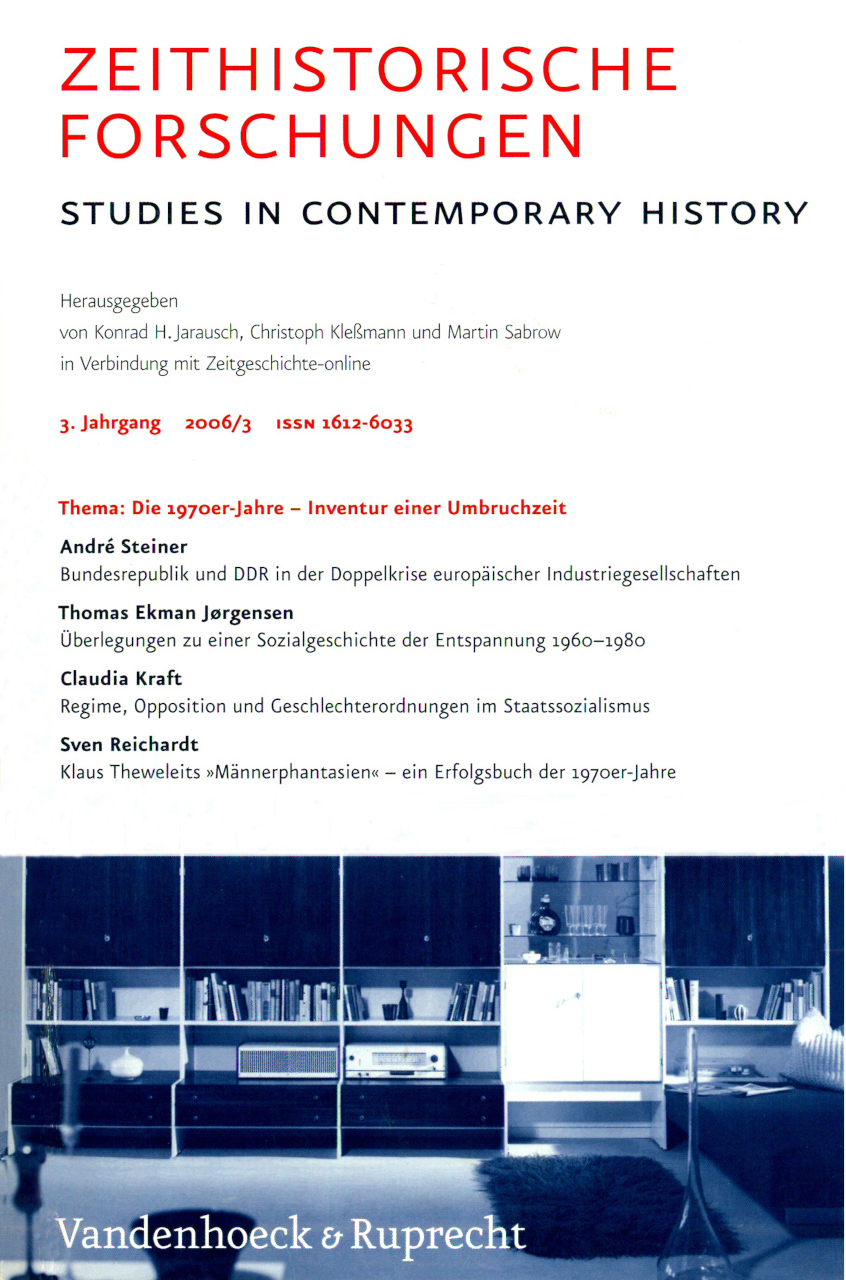Heft 3 / 2006
Aufsätze | Articles
Bundesrepublik und DDR in der Doppelkrise europäischer Industriegesellschaften
Zum sozialökonomischen Wandel in den 1970er-Jahren
AbstractDem Aufsatz liegt die These zugrunde, dass sich während der 1970er-Jahre in den europäischen Industriegesellschaften eine systemübergreifende Krise ausbildete. Sie ging von einer wirtschaftlichen Strukturanpassungskrise aus und mündete in eine Krise des Sozialstaates. Zugleich war sie im Ostblock wesentlicher Teil der finalen Systemkrise. Im Westen besaß die Krise Durchgangscharakter - allerdings mit bis heute reichenden Folgen. Anhand der wirtschaftlichen Entwicklung, des Arbeitsmarktes und des Sozialstaates werden für die Bundesrepublik und die DDR die Gemeinsamkeiten und die Unterschiede dieser Krisenprozesse aufgezeigt. Dabei wird der Blick auch auf die Wahrnehmung der neuen Probleme durch die Entscheidungseliten und deren Handeln gelenkt.
∗ ∗ ∗
This article claims that a crisis developed in European industrial societies during the 1970s, which affected both the East and the West. It began with a crisis concerning adaptability to economic structures, and led to a general crisis of the welfare state. In the Eastern bloc, this development was an inherent part of the crisis which led to the demise of states in the late 1980s. In the West, this crisis was shortlived, though its effects can still be felt today. By focusing on economic development, the labour market and the welfare state, the article reveals common aspects of this crisis as well as aspects specific to each system in the German Democratic Republic and the Federal Republic. It also draws attention to the way in which decision-making elites perceived the new issues and to the behaviour of these elites.Friedliches Auseinanderwachsen
Überlegungen zu einer Sozialgeschichte der Entspannung 1960–1980
AbstractDer Artikel skizziert die politische, kulturelle und wirtschaftliche Entwicklung der Gesellschaften Ost- und Westeuropas in der Ära der Entspannungspolitik. Die Hauptthese lautet, dass die diplomatische Annäherung der beiden Blöcke von einem gegenläufigen Auseinanderwachsen der west- und osteuropäischen Länder begleitet war. Während die westlichen Gesellschaften neue politische Aktionsmöglichkeiten in Form von sozialen Bewegungen erlebten, blieb dies im Osten wegen des Machtmonopols der kommunistischen Parteien unmöglich bzw. war mit weitaus größeren Schwierigkeiten verbunden. Auch neue (jugend)kulturelle Erscheinungsformen wie bestimmte Mode- und Musikströmungen konnten im Westen eine Normalität erreichen, die im Osten nicht möglich war. Die Wirtschaftskrise der 1970er-Jahre führte im Westen zu einem Ab- bzw. Umbau der fordistischen Produktionsweise, während die realsozialistischen Staaten an alten Strukturen festhielten. Während diese Trends der 1970er-Jahre heute fast teleologisch auf den Zusammenbruch des Kommunismus vorauszudeuten scheinen, war dies für die Zeitgenossen nicht der Fall. Im Gegenteil: Viele Beobachter sahen eine mögliche Konvergenz der beiden Systeme.
∗ ∗ ∗
This article examines the political, cultural and economic divide between Eastern and Western European societies during the period of détente. The author argues that, although this period was marked by political rapprochement, the societies within the two blocs drifted further apart. The West witnessed new forms of political action in the form of social movements, which were integrated into the standard repertoire of political activity, whereas similar developments in the East faced far greater hurdles or were rendered impossible in the face of the communist monopoly of power. Similarly, new cultural developments such as youth cultures, which attained a degree of normality in the West, were not possible in the communist world. The economic crisis of the 1970s drove the two societies further apart by modifying and dismantling the Fordist model in the capitalist countries, while the communist leadership hung on to orthodox ideas of production. While these trends appear, retrospectively, to render the collapse of communism predictable, this was not apparent to people at the time. Most observers, particularly in the 1970s, predicted that the two systems would converge.Paradoxien der Emanzipation
Regime, Opposition und Geschlechterordnungen im Staatssozialismus seit den späten 1960er-Jahren
AbstractDer Artikel betrachtet die späten 1960er- und die 1970er-Jahre als eine Umbruchszeit, in der in West- wie in Osteuropa fundamental neue Gesellschaftsentwürfe formuliert wurden. Ausgehend von 1968 als transnationalem Protestjahr wird gefragt, inwieweit sich die an Bedeutung zunehmenden Oppositionsbewegungen im östlichen Teil Europas von den neuen sozialen Bewegungen in Westeuropa unterschieden. Dabei werden die Geschlechterbeziehungen in den staatssozialistischen Gesellschaften ins Zentrum der Analyse gerückt, und es wird herausgearbeitet, inwieweit die Formung der Geschlechterverhältnisse durch staatliche wie oppositionelle Politik neue Gesellschaftsentwürfe beeinflusste. Die Konservierung traditioneller Geschlechterverhältnisse war sowohl für die Regime als auch für die oppositionellen Bewegungen funktional. Vor diesem Hintergrund wird verständlich, dass im östlichen Europa - im Gegensatz zu Westeuropa und den USA - aus den gesamtgesellschaftlichen Protestbewegungen keine einflussreiche Frauenbewegung hervorging.
∗ ∗ ∗
The article focuses on the late 1960s and 1970s as a period that witnessed political and societal changes as well as the rise of fundamentally new concepts of society in both Western and Eastern Europe. Taking 1968 as a starting point of transnational significance, it investigates differences between new oppositional movements in Eastern Europe and new social movements in the West. The article focuses in particular on gender relations within societies of the Eastern bloc. It demonstrates how the conceptions of these relations in policies of the regimes and within oppositional groups influenced projects for political change. Both regimes and oppositional movements preserved traditional gender relations in order to attain their respective political goals. Since gender relations played a key role in the formation of an oppositional identity, a women’s movement could hardly develop out of the broader movements which challenged the authorities of the socialist countries.Klaus Theweleits „Männerphantasien“ – ein Erfolgsbuch der 1970er-Jahre
AbstractKlaus Theweleits literaturwissenschaftliche Dissertationsschrift „Männerphantasien“ von 1977/78 wurde in fünf Sprachen übersetzt und mehr als zweihunderttausend Mal verkauft. Der Aufsatz ordnet dieses außergewöhnliche Erfolgsbuch in seinen Zeitkontext ein - in das linksalternative Milieu der Bundesrepublik der späten 1970er-Jahre. Sechs Faktoren dürften zur Resonanz auf die „Männerphantasien“ beigetragen haben: Erstens vollzog das Buch den Wandel von klassisch marxistischer zu psychologisch-postmoderner Theoriebildung nach; zweitens lieferte es mit der Faschismusdeutung einen Beitrag zu dem zentralen Milieuthema; drittens verstand sich das Buch als ein Beitrag zur damals hochaktuellen Geschlechterdiskussion; viertens begleitete und förderte es den Wandel zu einer „Politik der ersten Person“; fünftens bediente Theweleit die linksalternative Ästhetik, und sechstens schrieb er über Gewalt und Terrorismus als hochaktuelles Thema. Im zweiten Teil des Aufsatzes werden die „Männerphantasien“ als historiographische Leistung zur Körper- und Geschlechtergeschichte des Faschismus aus der Perspektive der heutigen Geschichtswissenschaft kritisch gewürdigt.
∗ ∗ ∗
Klaus Theweleit’s book ‘Male Fantasies’ (Männerphantasien, 1977/78), with which he obtained a doctorate in literary studies, has been translated into five different languages and has sold over 200,000 copies. In order to explain this remarkable success, the article contextualises and historicises the book as an expression of the sub- and counterculture of the new German left during the late 1970s. There are approximately six reasons why ‘Male Fantasies’ provoked such a broad response: first, it brought about a switch from classical Marxist to psychological and postmodern theories; second, it dealt with the most prominent topic of the 1970s - the fascination with fascism; third, it addressed highly topical gender issues; fourth, it expressed a new form of politics - relinquishing pure political theory in favour of the politics of everyday experiences; fifth, it adopted a style and aesthetics that were typical of the counterculture of the 1960s and 1970s; and sixth, it was a book about violence and terror, published shortly after the ‘German Autumn’ of 1977. The second part of the article evaluates the way in which ‘Male Fantasies’ contributed towards the historiography of fascism as body and gender history.
Debatte | Debate
Besprechungen | Reviews
Neu gelesen
Zitation
Redaktionsschluss
Erweiterte Suche

